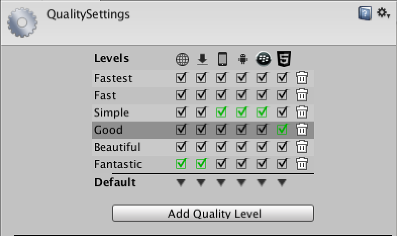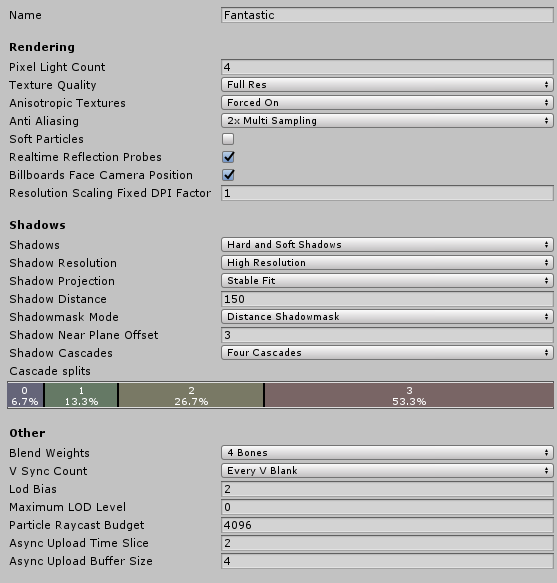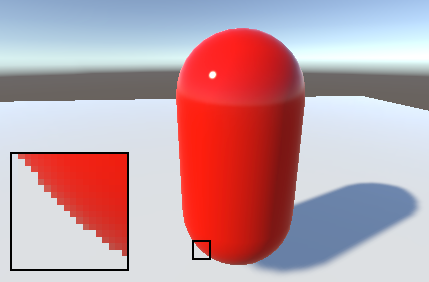How To Change Quality Of Image In Unity
Quality Settings
Switch to Scripting
Unity allows you to set the level of graphical quality it will attempt to render. Generally speaking, quality comes at the expense of framerate and and so it may be all-time not to aim for the highest quality on mobile devices or older hardware since it volition have a detrimental upshot on gameplay. The Quality Settings inspector (carte: Edit > Project Settings > Quality) is used to select the quality level in the editor for the chosen device. It is split into two main areas - at the top, at that place is the following matrix:

Unity lets you assign a name to a given combination of quality options for easy reference. The rows of the matrix allow you choose which of the dissimilar platforms each quality level will apply to. The Default row at the bottom of the matrix is non a quality level in itself but rather sets the default quality level used for each platform (a dark-green checkbox in a column denotes the level currently chosen for that platform). Unity comes with half-dozen quality levels pre-enabled only yous can add your own levels using the push below the matrix. You tin employ the trashcan icon (the rightmost column) to delete an unwanted quality level.
You tin click on the name of a quality level to select information technology for editing, which is done in the console below the settings matrix:

The quality options you tin choose for a quality level are as follows:
| Property: | Function: |
|---|---|
| Proper noun | The name that volition be used to refer to this quality level |
Rendering
| Property: | Function: |
|---|---|
| Pixel Light Count | The maximum number of pixel lights when Forward Rendering is used. |
| Texture Quality | This lets you choose whether to display textures at maximum resolution or at a fraction of this (lower resolution has less processing overhead). The options are Full Res, Half Res, Quarter Res and Eighth Res. |
| Anisotropic Textures | This enables if and how anisotropic textures will be used. The options are Disabled, Per Texture and Forced On (ie, always enabled). |
| AntiAliasing | This sets the level of antialiasing that will be used. The options are 2x, 4x and 8x multi-sampling. |
| Soft Particles | Should soft blending be used for particles? |
| Realtime Reflection Probes | Should reflection probes be updated during gameplay? |
| Resolution Scaling Fixed DPI Factor | Downscales the device's screen resolution beneath its native resolution. For more details, see the platform-specific Player Settings pages, such as Android Actor Settings and iOS Player Settings. |
Shadows
| Property: | Office: |
|---|---|
| Shadows | This determines which type of shadows should exist used. The available options are Hard and Soft Shadows, Hard Shadows Just and Disable Shadows. |
| Shadow resolution | Shadows tin can be rendered at several different resolutions: Low, Medium, High and Very High. The higher the resolution, the greater the processing overhead. |
| Shadow Project | At that place are 2 unlike methods for projecting shadows from a directional light. Shut Fit renders higher resolution shadows merely they can sometimes wobble slightly if the camera moves. Stable Fit renders lower resolution shadows but they don't wobble with photographic camera movements. |
| Shadow Cascades | The number of shadow cascades can exist set to aught, 2 or four. A college number of cascades gives better quality but at the expense of processing overhead (see Directional Light Shadows for further details). |
| Shadow Altitude | The maximum distance from photographic camera at which shadows will be visible. Shadows that fall across this distance will not be rendered. |
| Shadowmask Mode | Sets the shadowmask behaviour when using the Shadowmask Mixed lighting mode. Use the Lighting window (carte du jour: Window > Lighting > Settings) to set up this upwardly in your Scene. |
| Distance Shadowmask | Unity uses real-time shadows up to the Shadow Distance, and broiled shadows beyond it. |
| Shadowmask | hadowmask: Static GameObjects that bandage shadows ever bandage baked shadows. |
| Shadow Near Aeroplane Offset | Showtime shadow near airplane to account for big triangles being distorted by shadow pancaking. |
Other
| Property: | Function: |
|---|---|
| Blend Weights | The number of bones that can bear on a given vertex during an animation. The available options are 1, two or four bones. |
| VSync Count | Rendering can be synchronised with the refresh rate of the brandish device to avoid "tearing" artifacts (see below). You lot tin can choose to synchronise with every vertical blank (VBlank), every second vertical bare or non to synchronise at all. |
| LOD Bias | LOD levels are chosen based on the onscreen size of an object. When the size is between two LOD levels, the pick can be biased toward the less detailed or more detailed of the 2 models available. This is set equally a fraction from 0 to +infinity. When it is set between 0 and 1 it favors less detail. A setting of more than 1 favors greater particular. For instance, setting LOD Bias to 2 and having it change at 50% distance, LOD really only changes on 25%. |
| Maximum LOD Level | The highest LOD that will be used by the game. See note below for more Data. |
| Particle Raycast Budget | The maximum number of raycasts to use for approximate particle system collisions (those with Medium or Low quality). Meet Particle System Collision Module. |
| Async Upload Fourth dimension Slice | The corporeality of CPU fourth dimension in milliseconds per frame to spend uploading buffered textures to the GPU. See Async Texture Upload. |
| Async Upload Buffer Size | The size in MB for the Async Upload buffer. Encounter Async Texture Upload. |
MaximumLOD level
Models which take a LOD below the MaximumLOD level volition not be used and omitted from the build (which will save storage and memory space). Unity volition use the smallest LOD value from all the MaximumLOD values linked with the quality settings for the target platform. If an LOD level is included so models from that LODGroup volition be included in the build and always loaded at runtime for that LODGroup, regardless of the quality setting being used. Equally an example, if LOD level 0 is used in any quality setting then all the LOD levels will be included in the build and all the referenced models loaded at runtime.
Trigger-happy
The picture show on the display device is not continuously updated but rather the updates happen at regular intervals much like frame updates in Unity. All the same, Unity's updates are not necessarily synchronised with those of the brandish, and then it is possible for Unity to issue a new frame while the display is however rendering the previous one. This will result in a visual artifact chosen "tearing" at the position onscreen where the frame alter occurs.

It is possible to gear up Unity to switch frames just during the period where the brandish device is non updating, the so-called "vertical blank". The VSync option on the Quality Settings synchronises frame switches with the device's vertical blank or optionally with every other vertical blank. The latter may exist useful if the game requires more than 1 device update to complete the rendering of a frame.
Anti-aliasing
Anti aliasing improves the appearance of polygon edges, so they are not "jagged", but smoothed out on the screen. However, it incurs a operation cost for the graphics card and uses more video memory (in that location'south no cost on the CPU though). The level of anti-aliasing determines how smooth polygon edges are (and how much video memory does it consume).


Yet, congenital-in hardware anti-aliasing does not work with Deferred Shading or HDR rendering; for these cases you'll need to use Antialiasing Paradigm Effect.
Soft Particles
Soft Particles fade out near intersections with other scene geometry. This looks much nicer, however information technology'due south more expensive to compute (more complex pixel shaders), and only works on platforms that back up depth textures. Furthermore, you accept to use Deferred Shading or Legacy Deferred Lighting rendering path, or make the camera render depth textures from scripts.


-
2017–09–18 Page amended with limited editorial review
-
Shadowmask Mode added in 2017.i NewIn20171
Did y'all find this folio useful? Please give it a rating:
Thanks for rating this page!
Thanks for letting united states know! This page has been marked for review based on your feedback.
If you have fourth dimension, you can provide more information to help us ready the problem faster.
Provide more than information
You've told us this page needs code samples. If you'd like to help us farther, yous could provide a code sample, or tell u.s.a. well-nigh what kind of code sample you lot'd like to see:
Y'all've told united states of america there are lawmaking samples on this page which don't work. If you lot know how to set it, or have something amend we could use instead, please let us know:
You've told usa in that location is information missing from this page. Please tell us more near what's missing:
You've told u.s. at that place is incorrect information on this page. If you know what we should change to make it correct, please tell us:
You've told the states this page has unclear or confusing data. Please tell u.s. more than about what you found unclear or confusing, or let us know how nosotros could make information technology clearer:
You've told us there is a spelling or grammar error on this folio. Please tell us what's incorrect:
You've told us this page has a trouble. Please tell u.s. more well-nigh what's incorrect:
Cheers for helping to make the Unity documentation better!
Source: https://docs.unity3d.com/2018.1/Documentation/Manual/class-QualitySettings.html
Posted by: prowellworly1971.blogspot.com


0 Response to "How To Change Quality Of Image In Unity"
Post a Comment